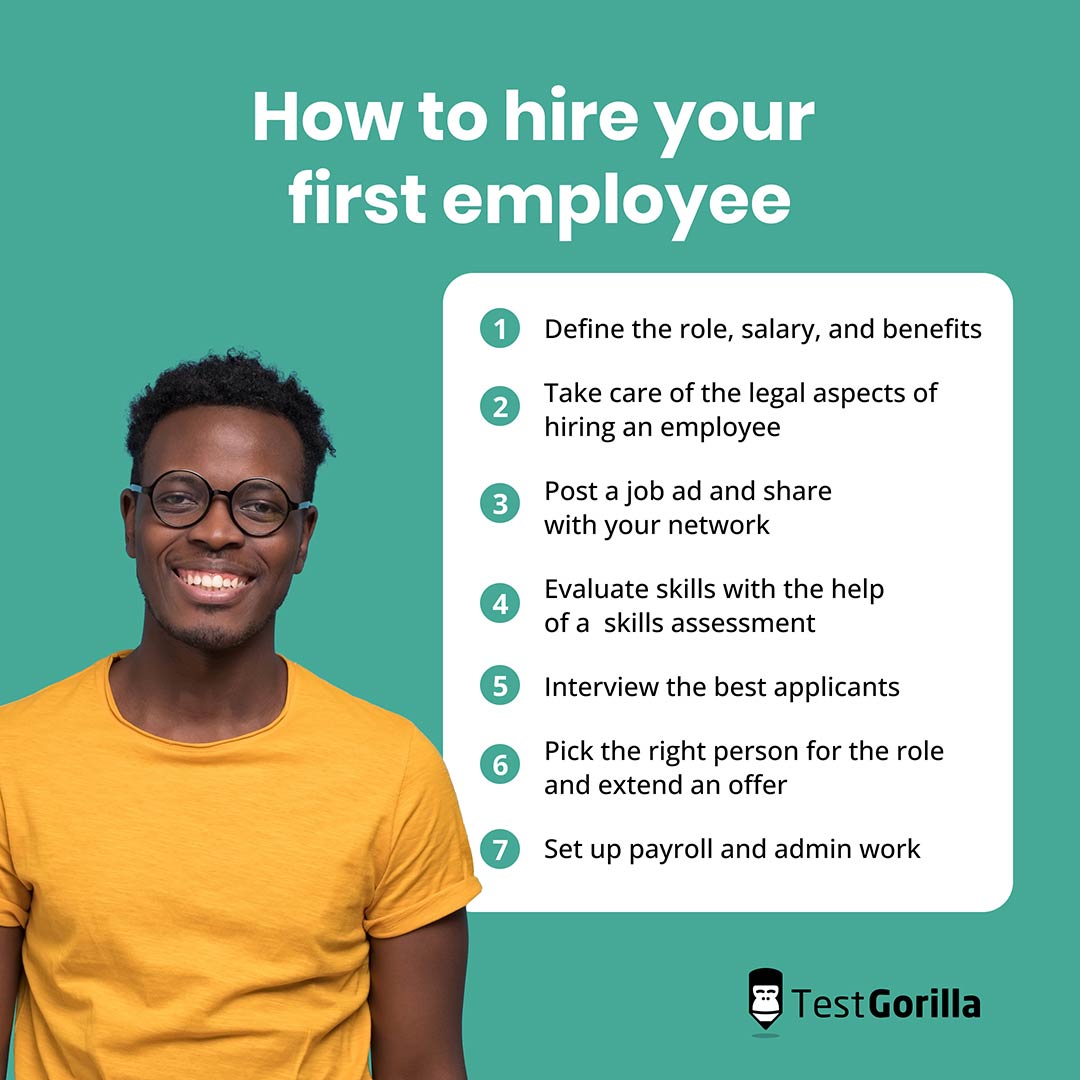Hiring your first employee is a crucial step for any small business owner, so you need to be sure you get everything right. It also comes with a number of legal and practical considerations, which we’ll explore in this article.
Your first employee will play an important role in shaping not just your company’s future success, but also its culture and values. So, you must be sure you’re able to make the right hiring decision from the first try; after all, a small business has very little leeway for error and making the wrong hire can be very costly.
But how exactly do you define the role and job responsibilities of your first employee? How can you decide what skills you should look for? And how can you assess them objectively and without bias?
In this article, we’ll talk about all this – and more. Here, you’ll find out all you need to know about:
When to hire your first employee
What your hiring process should look like
How to decide which skills are the most important ones
How to evaluate and compare candidates
What costs hiring an employee entails (besides salary)
Table of contents
- When should you hire your first employee?
- How to hire your first employee: A step-by-step guide
- Hard skills you need to look for in your first employee
- Your first employee’s soft skills
- How to test your first employee’s skills
- Where to find your first employee
- The costs of hiring an employee
- Use a skills-first approach to hiring and build a successful business
When should you hire your first employee?
If you’ve been managing your business on your own for a while, you’re probably used to taking on all kinds of responsibilities and roles – but, let’s face it, you cannot be an expert in everything. At some point, you’ll need to start delegating some of your work to someone else in order to:
Scale your business without limiting yourself to only what you’re capable of doing
Avoid overworking yourself and burning out
Get expert help on specific tasks
Free up enough time and energy to start thinking about growth
And while hiring a freelancer can help with all that temporarily, at some point you’ll probably need to find a person who’s truly invested in the success of your business and who can be available to work with you full time.
But how do you know it’s time to actually hire someone?
Here are some of the clear signs that your business will benefit from hiring your first employee:
You have a clear idea of how to grow your business but you simply don’t have the capacity to explore the different growth opportunities you’re seeing
You’re starting to turn down projects that would otherwise be a great fit
You’re no longer able to provide the same customer service as before – and your customers are starting to notice
You’re falling behind on admin work or bookkeeping and are constantly feeling stressed about it
Your business’ financial situation is stable and you know where your revenue in the next quarters will be coming from and what fluctuations you might expect
You could use the help of a person who has a specific skill set that’s different from yours
You notice the rate of your business’ growth is stagnating, but not because market demand is shrinking
If you have started to notice any of the above signs, it might be time to start thinking about hiring your first employee, or at the very least, an independent contractor. This will enable you to focus on the tasks you’re truly passionate about and that move the needle.
Things to consider before hiring your first employee
There are a few considerations you need to make before you start the hiring process.
Needs and requirements: What tasks do you need help with and do they fit within a single role? To make a successful hire, you need to know what exactly they’ll do – and not just expect one person to do your bookkeeping, manage your social media accounts, and take care of customer support.
Culture and values: When you’re operating as a one-man army, you live and breathe your business’ culture – so you probably haven’t given much thought about it or felt the need to define it. Before you make your first hire, however, you need to describe your culture and values to make sure you attract the right talent.
Budget: Are you able to afford to hire an employee, and if yes, what’s the budget you can allocate to this first hire? Your business should generate enough revenue to cover the new person’s salary, benefits, taxes, and other associated costs, while still being profitable.
Type of contract: Do you need someone to work with you full-time, or would you rather hire a part-time employee in the beginning? Would hiring a freelancer make sense or do you need someone who’s fully invested in your business?
How to hire your first employee: A step-by-step guide
Hiring your first employee probably feels like a daunting task at the moment – but with the right process and talent assessment tools, you can make it much simpler. Below, you’ll find our step-by-step guide to making your first hire:
1. Define the role, salary, and benefits
Although your first employee might sometimes need to wear a few different hats, it’s still essential to clearly define the role before you start the hiring process. This will give you clarity and is also instrumental in attracting the right talent.
Write a detailed job description, in which you describe your first employee’s future high-level responsibilities and day-to-day tasks. Make sure you’re realistic with your requirements and aren’t trying to fit the tasks of three distinct roles into one: There’s only so much a single person can do.
Next, look at your budget and average salaries for this role in your area. Define the salary based on that and consider benefits such as health insurance, retirement plans, and time off.
2. Take care of the legal aspects of hiring an employee
Next, you must take care of the legal requirements for hiring an employee. There are a few steps you need to take, such as to:
Get a federal Employee Identification Number (EIN)
Register with your state’s unemployment insurance agency
Make sure you know how to check employees’ work eligibility
Get workers’ compensation insurance, and more
These vary from state to state, so make sure you check the rules that apply to your area.
3. Post a job ad and let your network know you’re hiring
Now, you need to let the world know that you’re hiring. Post an ad on job boards such as LinkedIn, Monster, and Indeed, and don’t forget to ask your professional network for referrals, too.
4. Evaluate skills with the help of a skills assessment
By now, you’ll have received a number of applications. Skills assessments are the best way to evaluate your candidates’ skills fairly and objectively, without letting unconscious biases seep into your selection process.
With TestGorilla, you can build an assessment of up to five skills tests and ask all candidates to take it. This way, you’ll be able to evaluate their expertise, knowledge, and soft skills quickly and identify your best talent.
5. Interview the best applicants
Once you’ve identified your most skilled candidates, it’s time to invite them to an interview to gain a deeper understanding of their experience and the value they can bring to the table.
For this phase of the hiring process, it’s best to use structured interviews (just like Google does), where you ask everyone the same questions in the same order. This enables you to focus on each person’s skills and compare answers rather than rely on your personal preferences or gut feelings.
6. Pick the right person for the role and extend an offer
By now, you’ll have plenty of information about each one of your top candidates, enabling you to make the right hiring decision.
Extend an offer to the one who best fits your needs and discuss all the details, such as the salary, start date, work hours, benefits, and more.
7. Set up payroll and take care of the admin work
Once you make a hire, you need to:
Set up your payroll
Report the employment to your state registry
Make sure you’re maintaining accurate employee records
Employee records include details such as your employee’s full name, mailing address, start date, working hours and hours worked each week, earnings, payment dates, and more.
Hard skills you need to look for in your first employee
The hard skills will depend on your industry and the specific role of your first employee.
Here are some examples of hard skills to look for, based on the role for which you’ll be hiring:
Administrative assistant: If you’re hiring an admin assistant, they need to have excellent schedule management and email management skills and be proficient in Microsoft Windows and Microsoft Office Suite
Customer service representative: Customer support skills are essential for your first customer service representative should have; customer relationship management (CRM) software, such as HubSpot CRM or Salesforce CRM could be nice to have
Salesperson: Look for a salesperson who knows the ins and outs of CRM software and has a solid understanding of different sales frameworks; depending on your industry, you’d need to assess B2C or B2B sales skills, too
Marketing expert: Marketing analytics, product marketing management, email marketing, PPC advertising are all essential for a well-rounded marketing professional
Graphic designer: Look for a person who’s proficient in graphic design software, such as Adobe Photoshop or Adobe Illustrator; if you need them to help you build your website, look for someone who has a solid understanding of UX/UI design and frontend web development
Your first employee’s soft skills
The success of your business will depend on your first employee’s ability to build strategic business relationships and manage their own workload and time efficiently. They also need to be excellent problem solvers and know how to make the most out of every situation with sometimes limited resources and time.
Here are some of the most essential soft skills you should look for:
Communication
Your first employee needs to be an excellent communicator to build long-standing relationships with your clients and partners.
They need to know how to adapt their communication style to different people and situations, read non-verbal cues, use professional business etiquette, express themselves clearly and effectively to get their point across, and listen attentively to what others have to say.
Time management
In a small business effective time management is a must – there’s always a lot to do and everything seems urgent, so you need someone who knows how to prioritize their responsibilities, manage their schedule well, and make accurate estimates of the time each task should take.
Business judgment
Regardless of the specific role for which you hire them, your first employee needs to have a strong intuition for growth opportunities and know how to take advantage of each situation to the benefit of your company. They also need to know how to evaluate risk and take appropriate measures to shield your business from it.
Problem solving
Small businesses often have limited resources to deal with different challenges, so the person you hire needs to be an excellent problem solver and a fast thinker. Look for someone who’s proactive and who isn’t afraid to try out new approaches to address roadblocks.
How to test your first employee’s skills
The best way to evaluate your applicants’ skills is to use an objective and impartial skills assessment process. Pre-employment skills testing is ideal for that, because it enables you to evaluate everyone’s abilities and knowledge quickly and accurately without any bias:
Everyone takes the same tests and has a fair chance to show their skills
The platform grades tests automatically, leaving no place for interpretation or personal preferences
You’re able to compare candidates based on hard data rather than on information from their resumes
TestGorilla offers 300+ skills tests that you can use to evaluate any skill, ranging from cognitive abilities to role-specific technical knowledge and anything in between. You can combine up to five skills tests in one skills assessment for a well-rounded evaluation of all candidates.
Here are some examples of combinations of tests you can use for different roles:
Administrative assistant: Time management, communication, email management, Microsoft Excel skills test, administrative assistant skills
Customer service representative: Communication, Zendesk CS, Hubspot CRM
Salesperson: B2C or B2B sales, communication, negotiation, culture add
Marketing expert: Marketing analytics, SEO outreach, email marketing, PPC advertising, culture add
Graphic designer: Adobe Photoshop, Adobe Illustrator, UX/UI design, communication, time management
For more skills tests, head on to our test library.
Where to find your first employee
There are a few ways you can use to source talent when hiring your first employee:
Use job platforms: Post a job ad on platforms like LinkedIn, Monster, Indeed, or Glassdoor
Reach out to passive candidates: You can also use LinkedIn’s search function to find qualified candidates in your area and reach out to them directly
Use your network: Let your professional and personal network know that you’re looking to make your first hire; referrals are an excellent way to find skilled people eager to take on a new challenge
Go to industry-specific events: Go to local networking events such as conferences or workshops to connect with experts in your field who might be interested in helping you grow your business
The costs of hiring an employee
The salary you pay will depend on the role, the skills you need your first employee to have, your industry, and the cost of living in your area, if you’re hiring locally.
That being said, your employee’s salary is not the only cost you need to consider. You also need to factor in the costs of:
Employment taxes
The employee’s benefits
Job ad fees
Recruitment costs and paperwork
Payroll management costs
Onboarding and training costs
Make sure you calculate everything carefully before you begin your recruitment process.
Use a skills-first approach to hiring and build a successful business
One of the best ways to build a successful, scalable business is to use a skills-first approach to hiring – and to implement this strategy right from the start, when you’re hiring your very first employee.
This enables you to find and attract the best talent and make each hiring decision with confidence and ease.
Use TestGorilla to hire your first employee without guesswork and unconscious biases. Sign up for a free demo or try out our free plan today.
Related posts
Hire the best candidates with TestGorilla
Create pre-employment assessments in minutes to screen candidates, save time, and hire the best talent.
Latest posts
The best advice in pre-employment testing, in your inbox.
No spam. Unsubscribe at any time.

Hire the best. No bias. No stress.
Our screening tests identify the best candidates and make your hiring decisions faster, easier, and bias-free.
Free resources
This checklist covers key features you should look for when choosing a skills testing platform
This resource will help you develop an onboarding checklist for new hires.
How to assess your candidates' attention to detail.
Learn how to get human resources certified through HRCI or SHRM.
Learn how you can improve the level of talent at your company.
Learn how CapitalT reduced hiring bias with online skills assessments.
Learn how to make the resume process more efficient and more effective.
Improve your hiring strategy with these 7 critical recruitment metrics.
Learn how Sukhi decreased time spent reviewing resumes by 83%!
Hire more efficiently with these hacks that 99% of recruiters aren't using.
Make a business case for diversity and inclusion initiatives with this data.


















